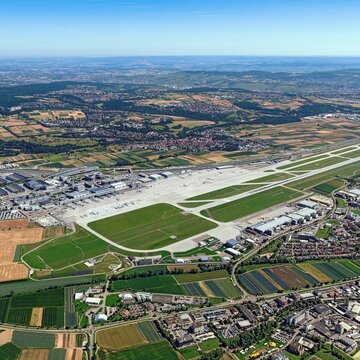Projects at Stuttgart Airport

STRzero
Our path to becoming a climate-friendly airport

Stuttgart Airport has set itself a clear goal: by 2040, CO2 emissions are to be reduced to an absolute minimum. To this end, the airport is pursuing its STRzero climate strategy, which centres on a master plan for climate and energy.
The concept takes a holistic approach to climate protection. It covers the topics of energy efficiency, energy generation, smart grids, mobility and transport. The most important lever for reducing greenhouse gas emissions and achieving ambitious climate targets is the consistent energy-efficient renovation of commercial buildings. This primarily includes the terminals, some of which are over 30 years old.
New legal requirements for energy efficiency and stricter standards for safety and fire protection also make it essential to renovate passenger buildings. That is why Flughafen Stuttgart GmbH is currently investigating how the buildings can be renovated to achieve maximum energy efficiency as part of the STRzero Terminal project.
Another focus – solar energy: the energy yield from solar energy is to be increased tenfold. The number of facilities is to be increased from the current 7 to 32.
To ensure that the entire energy system is operated efficiently and that the electricity generated in-house is used optimally, Stuttgart Airport is building an intelligent power grid. It links generation, storage and consumption. The airport’s vehicle fleet will also be further electrified. Additional charging infrastructure is also required.
This is how we are moving step by step towards STRzero – for more climate-friendly airport operations.
GOLIAT project
Liquid hydrogen for the aviation of the future

How can aircraft be refuelled safely and reliably with liquid hydrogen (LH2) in the future? To answer this question and make aviation more sustainable, Airbus is working with stakeholders from research, industry and airport operations to advance the GOLIAT project. The aim is to develop and test safe and reliable procedures for handling LH2 at European airports.
The project is funded by the Horizon Europe EU initiative. A total of EUR 10.8 million will be available for this purpose over the next four years. Research and testing are being conducted at three locations in Europe: at the airports in Budapest, Rotterdam-The Hague and Stuttgart.
The project brings together expertise from many different fields. In addition to Airbus, nine other partners from eight countries are collaborating on the project:
- Chart Industries
- Budapest Airport
- Rotterdam The Hague Airport
- Stuttgart Airport
- H2FLY
- Hanover Leibniz University
- Royal Schiphol Group
- Delft University of Technology
- VINCI Airports
This is how we work together to create knowledge for the aviation industry of tomorrow.

Cloud cameras
For smarter energy management
Stuttgart Airport is committed to renewable energies to achieve its climate targets. By 2040, solar power production at the airport is set to increase tenfold. A smart energy system (smart grid) should help to balance out fluctuating yields, for example on very sunny or cloudy days.
An important component of this system: cloud cameras. They record cloud movements every second and, together with other weather data, generate accurate forecasts of expected solar power production at the airport. This enables energy management to plan better – for example, when electric vehicles should be charged.
For scientific purposes, five cloud cameras were temporarily distributed across the campus: four from Offenburg University of Applied Sciences and one from the Centre for Solar Energy and Hydrogen Research Baden-Württemberg.




